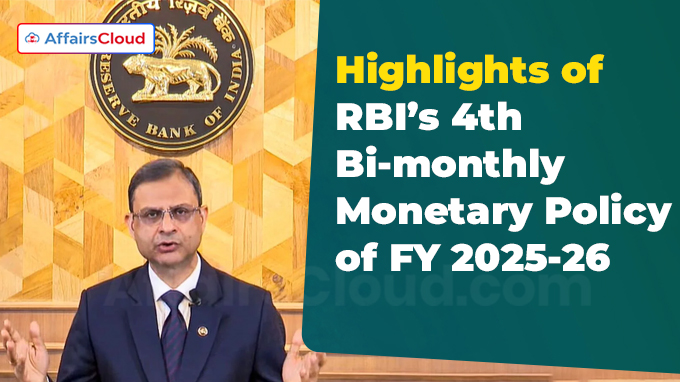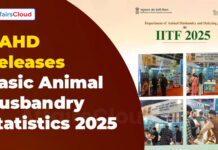The Reserve Bank of India (RBI) conducted the 57th and 4th Bi-monthly Monetary Policy Committee Meeting (MPC) of Financial Year (FY) 2025-26 from September 29 to October 1,2025 under the chairmanship of Shri Sanjay Malhotra, Governor, RBI.
- The meeting was attended by the MPC members Dr. Nagesh Kumar, Shri Saugata Bhattacharya, Prof. Ram Singh, Dr. Poonam Gupta and Shri Indranil Bhattacharyya.
Exam Hints:
- What? RBI 4rd Bi-monthly MPC FY26
- Policy Rates: Repo – 5.5%, Reverse repo – 3.35%, SDF – 5.25%, MSF – 5.75%
- GDP: 6.8% for FY26
- Inflation: 2.6% for FY26
- DICGC: New RBP model – lesser premium
- BSBDA: free digital banking services
- Ombudsman: RB-IOS more coverage, IO scheme – 2 tier
- Improve credit flow: loan against shares limit increased, financing acquisitions, August 2016 framework withdrawn, NBFC infra financing cost reduced, license for new UCBs
- Rupee internationalisation: Indian rupee loans, expansion of SRVA, reference rates
- Easing rules: banks and their subsidiaries operate in a similar line of business.
RBI retains repo rate at 5.5%, Maintains ‘Neutral’ stance:
Rate unchanged: All the MPC members voted unanimously to keep the policy repo rate under the liquidity adjustment facility (LAF) unchanged at 5.5%.
- Consequently, the standing deposit facility (SDF) rate shall remain unchanged at 5.25% and the marginal standing facility (MSF) rate and the bank rate at 5.75%
- The MPC also decided to continue with the neutral stance.
Reason: The MPC observed that inflation has moderated; however, since the effects of earlier monetary policy actions and recent fiscal measures are still transmitting through the economy, it considered it prudent to await greater clarity before undertaking further action.
RBI Policy Rates:
| Category | Rate |
|---|---|
| Repo Rate | 5.50% |
| Reverse Repo Rate | 3.35% |
| SDF | 5.25% |
| MSF | 5.75% |
| Cash Reserve Ratio (CRR) | 3.5% |
| Statutory Liquidity Ratio (SLR) | 18.00% |
| Bank Rate | 5.75% |
Note*Current Account Deficit moderated to 0.2% of GDP this year
The Reserve Bank also announced a reduction in the CRR by 100 bps to 3.0 per cent of net demand and time liabilities (NDTL) in a staggered manner during September-November 2025. This reduction in four equal tranches of 25 bps each with effect from the fortnights beginning September 6, October 4, November 1, and November 29, 2025.
Hence As of October 2025 CRR will be 3.5
RBI projects GDP growth at 6.8% for FY26
GDP Forecast: The RBI revised India’s Gross Domestic Product (GDP) growth forecast for Financial Year 2025-26 (FY 26) upwards to 6.8% from earlier estimate of 6.5%.
- The reason behind the revised projection is domestic growth supported by strong consumption, investments, government spending, with supportive factors like a good monsoon, GST (Goods and Services Tax) rationalisation, better credit flow and rising capacity utilisation.
Quarterly Forecast: India’s real GDP grew 7.8% in Quarter 1 (Q1: April-June 2025) FY 26, up from 7.4% in the previous quarter, driven by strong private consumption and fixed investment.
- The projection for FY26 Q2 (July-September 2025) at 7.0%; Q3 (October-December 2025) at 6.4%, Q4 (January-March 2026) at 6.2%.
- The real GDP growth for Q1:2026-27 is projected at 6.4%
CPI inflation revised downward to 2.6% for FY26
Inflation Projection: Consumer Price Index (CPI) inflation for FY26 is now projected at 2.6% (lowered by 50 basis points) with Q2 at 1.8%; Q3 at 1.8%; and Q4 at 4.0%.
- The CPI inflation for Q1:FY27 is projected at 4.5%
Risk Based Premium Framework for Deposit Insurance in India
Existing Framework: Deposit Insurance and Credit Guarantee Corporation (DICGC), under the DICGC Act, 1961 has been operating the deposit insurance scheme since 1962 on a flat rate premium basis.
- At present, the banks are charged a premium of 12 paise (p) per Rs.100 of assessable deposits. The existing system’s major drawback is its inability to distinguish between banks based on their risk profile.
Proposed framework: Under the new Risk Based Premium (RBP) model, banks demonstrating greater financial stability and robustness will be rewarded with a significantly lower premium payout, fostering better risk management across the sector.
Free digital banking service to basic savings account holders
BSBD Account: In a major step toward strengthening financial inclusion in India, the RBI has announced that Basic Savings Bank Deposit Account (BSBDA) holders will now have access to full-fledged digital banking facilities.
- Until now, digital banking services such as mobile and internet banking were largely reserved for regular savings account holders.
- By expanding services, RBI is bridging this digital divide and ensuring that even entry-level account holders can enjoy the same digital benefits as mainstream customers.
Reserve Bank – Integrated Ombudsman Scheme, 2021 (RB-IOS)
Existing coverage: The Regulated Entities (RE) currently covered under the RB-IOS include Commercial Banks (CB), Regional Rural Banks (RRB), Scheduled Primary (Urban) Co-operative Banks (UCBs), Non-Scheduled Primary (Urban) Co-operative Banks with deposits size of Rs.50 crore (cr) and above, select Non-Banking Financial Companies (NBFC) and Credit Information Companies (CIC).
Increased coverage: In the MPC meeting, it was decided to bring State Co-operative Banks (SCB) and District Central Co-operative Banks (DCCB), which were previously under National Bank for Agriculture and Rural Development (NABARD), within the scope of the RB-IOS.
Strengthening Internal Ombudsman (IO) mechanism
Strengthening IO: The RBI has institutionalized the Internal Ombudsman (IO) mechanism in select REs which enables an independent apex level review of complaints that are being rejected by the Regulated Entities (RE).
- To further improve upon the efficacy of this mechanism, it is proposed that the IOs be equipped with compensation powers and be allowed access to the complainant, aligning the role of IOs more closely with that of the RBI Ombudsman.
- Additionally, a two-tiered structure may be introduced within REs for grievance redress prior to escalation to the IO.
Measures to improve flow of credit
Limit increased and removed: It is proposed to enhance limits for lending by banks against shares from Rs.20 lakhs to Rs.1 cr and for IPO (Initial Public Offer) financing from Rs.10 lakhs to Rs.25 lakhs per person.
- The RBI has also proposed to remove the regulatory ceiling on lending against listed debt securities.
Financing Acquisition: The RBI met the long-standing demand of the Indian banking industry by allowing banks to finance acquisitions by Indian corporates, a move that also expands banks’ capital market lending in the country.
August 2016 framework withdrawn: It is proposed to withdraw RBI’s August 2016 framework on Enhancing Credit Supply for Large Borrowers through Market Mechanism (with credit limit from banking system of Rs 10,000 crore and above).
- The framework originally aimed to address concentration risk arising from aggregate credit exposure of the banking system to a single large corporate and encourage such large corporates to diversify their sources of funding.
- While the Large Exposure Framework limits credit concentration risk at the individual bank level, system-wide concentration risks will be addressed, when required, through macroprudential tools.
Infrastructure financing cost: To reduce the cost of infrastructure financing by NBFCs, it is proposed to reduce the risk weights applicable to lending by NBFCs to operational, high quality infrastructure projects.
UCBs: Since 2004, licensing for Urban Co-operative Banks (UCBs) had been paused. Considering the positive developments in the sector during the last two decades and in response to the growing demand from the stakeholders, the RBI proposes to publish a discussion paper on licensing of new UCBs.
Unveils three measures to boost rupee internationalisation
Indian rupee loans: The authorised dealer (AD) banks will now be permitted to extend loans in Indian Rupees to non-residents from Bhutan, Nepal and Sri Lanka for trade-related transactions.
- As per the Ministry of Commerce (MoC), 90% of India’s exports to South Asia were to these four nations in 2024/25, amounting to nearly USD 25 billion (bn).
Reference rates: The RBI plans to establish transparent reference rates for currencies of India’s major trading partners.
- The step aims to make pricing more predictable and strengthen the use of rupee in invoicing and settlement of international trade.
Usage of SRVA expands: The balances in Special Rupee Vostro Accounts (SRVAs), which currently facilitate trade settlement in local currency, will now be made eligible for investment in corporate bonds and commercial papers.
- Already, RBI had allowed foreign investors to invest their surplus SRVA balances into central government securities.
Eases rules by dropping overlap curbs on banks, group entities
Regulatory restriction on overlap: The RBI informed that it has dropped the proposed restriction on overlaps in business activities between banks and their group entities from the final guidelines on “Forms of Business and Prudential Regulation for Investments (issued in October 2024).”
- This means that now banks and their NBFC can operate in a similar line of business without banks having to merge or divest their stakes in their subsidiaries.
Important Definitions:
Repo Rate: It is the interest rate at which the RBI lends money to commercial banks for short-term needs, against government securities.
Reverse Repo rate: It is the interest rate at which the RBI borrows money from commercial banks, usually for short durations.
Reserve Bank – Integrated Ombudsman Scheme, 2021 (RB-IOS): It was launched in November 2021, to provide cost-free redress of customer complaints involving deficiency in services rendered by entities regulated by RBI, if not resolved to the satisfaction of the customers or not replied to within a period of 30 days by the RE.
Internal Ombudsman (IO) scheme: The IO mechanism was set up with a view to strengthen the internal grievance redressal system of banks and to ensure that the complaints of the customers are redressed at the level of the bank itself by an authority placed at the highest level of bank’s grievance redressal mechanism so as to minimize the need for the customers to approach other fora for redressal.
Special Rupee Vostro Account (SRVA): These are designated accounts enabling foreign entities to settle transactions in Indian Rupees with Indian banks, promoting INR use in international trade.





